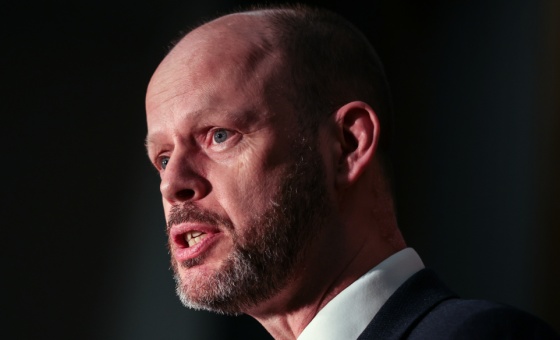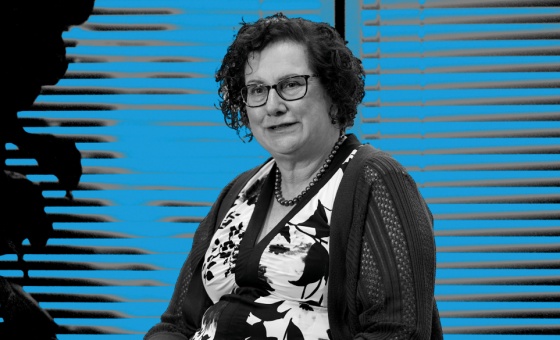This is the last article you can read this month
You can read more article this month
You can read more articles this month
Sorry your limit is up for this month
Reset on:
Please help support the Morning Star by subscribing here
AFTER 35 years, the NHS Gender Identity and Development Service (GIDS) clinic closes its doors for good this Sunday.
This service catering for children and young people with gender issues, and based at north London’s Tavistock and Portman Foundation Trust, announced its closure in 2022 following criticism from an independent review conducted by Dr Hilary Cass.
It is to be replaced by two new regional gender clinics, and previous treatment using so-called “puberty blockers” — drugs which delay the changes of puberty — has been restricted, with the NHS announcing last week: “We have concluded that there is not enough evidence to support the safety or clinical effectiveness of puberty-suppressing hormones to make the treatment routinely available at this time.”
So in a time of uncertainty, controversy and rethinking of best practice for children and young people, last weekend’s Clinical Advisory Network on Sex and Gender (CAN-SG) conference — the first such event the group has held — could not have been more timely.
The conference, held under the slogan derived from the Hippocratic oath, “First do no harm,” brought together clinicians, scientists and others at the Royal College of General Practice in Euston Square to explore what had gone wrong at GIDS, failures of the NHS and the lack of high-quality data to assist decision-making.
Clinical psychologist Dr Anna Hutchinson, who worked at GIDS between 2013 and 2017 and was one of several staff who raised concern over practices there during that time, explained that part of what had set alarm bells ringing was “a huge increase in the number of referrals of young people to the clinic between 2008/9. And 2022/3 it went up by 10,000 per cent — this is extraordinary,” she emphasised, “I cannot find anything in the literature which is equivalent.
“We were aware that not only were the numbers going up but the complexity was going up and these young people had incredibly complex lives and huge amounts of co-morbidities,” she added.
Hutchinson said that a culture developed at GIDS where these complicating factors were not discussed; that these young people presenting at the clinic with gender dysphoria had multiple different psychological issues that needed resolving.
“Alternative hypotheses — necessary in science — became themselves taboo and people argued that they were in themselves damaging and as a result extraordinary hypotheses became in a sense understood to be facts. And as a result we had extraordinary clinical practice following on from those extraordinary hypotheses.”
She added: “So people raised concerns about this. People raised concerns in lots and lots of forums and eventually NHS England got involved and they commissioned Hilary Cass to conduct an evidence review, so in January 2020 they put together a working group to look at the published evidence on the use of puberty blockers and cross-sex hormones in children and young people.”
Cass’s interim report, published in 2022, concluded that “the evidence just wasn’t of good enough quality to claim anything in either direction,” Hutchinson said.
Although Cass’s final report has not yet been published — it is imminent in the next few weeks — NHS England is now steering towards a more cautious approach towards treatment of children and young people due to this lack of evidence over puberty blockers — and England is not the first country to do so.
Keynote speaker Riittakerttu Kaltiala, chief psychiatrist at the department for adolescent psychiatry in Tampere University Hospital, explained how the public health service in Finland had followed a similar pattern, after it was the first country to perform a systematic scientific review of the evidence.
Giving the background, she said: “Services for adults were established in the 1990s and three teams for minors were opened in 2011. The opening of the teams for minors did not arise from needs recognised in child and adolescent psychiatry but there was great political pressure — it came from adult psychiatry and political pressure, activists and politicians, the notion that we should be providing these services for minors as well.”
She said that based on practitioners’ early understanding, “we expected to find out that in Finland there would be about 20 minors at any given time who would present with gender dysphoria […] We expected to receive very few cases with mainly childhood onset gender dysphoria that would have intensified in puberty; they would be predominantly the male sex […]
“However what we actually saw — the young people who contacted were 85 per cent biological girls and this has continued until today […] and they continued to have a great over-representation of the young people of the female sex.”
Kaltiala explained that the treatment they were offering did not seem to be effective: “After a little while still we had a group of adolescents who had proceeded to hormonal treatments and we started to see that they were actually not getting better, the adolescents did not thrive.
“Contrary what we had been suggested from the literature and our international networks we started to see that they were not getting better as to psychiatric symptoms and adolescent functioning […]
“We did not see the expected improvements in any domains of life that we were hoping to see.
“Therefore we could not be convinced that it was generally in the best interests of those adolescents to encourage medical gender reassignment and the gender identity teams under all these pressures requested the national body, COHERE Finland, to issue national guidelines for what kind of treatments are indicated for whom in the publicly funded health services and the national guidelines for treatment were issued in 2020 […]
“COHERE Finland performed a systematic review of the then literature and found the evidence base for medical interventions initiated during developmental years to be on a very weak scientific basis and this is why the guideline[s] became so restrictive.”
Sociologist, Professor Michael Biggs of Oxford University, said that it was important to question “whether cross-gender behaviour requires medicalisation.”
“It’s not clear why this should be regarded as a disease or a pathology,” he said. “Moreover we know that there’s a strong association between cross-gender behaviour and same-sex attraction. More feminine boys have a higher chance of coming out as gay.”
And consultant psychiatrist Az Hakeem also noted a link between gender non-conformity in young people and them growing up to be gay.
“GIDS encouraged social transition, facilitated transition at school and seemed to make no attempts to encourage the notion of gender non-conformity as developmentally normal,” he said.
“GIDS was created to cater for children who are not seeming to be like caricature stereotypes of ‘boyish boys’ or ‘girly girls.’ When I was at GIDS what I observed was a transing factory. Young children were being brought in by parents who had noticed their child was showing gender non-conforming behaviour. I saw camp boys and tomboy girls but instead of any possibility that these children would grow up to be gay adults, the clinic seemed invested in reinforcing sex stereotyped cliches and encouraging the notion of the trans child.
He added: “I remember asking the original lead of the clinic ‘Isn’t what you are doing mad? Surely if left alone, these camp young boys will just grow up to be gay adults without a gender dysphoria?’ The response I got was ‘Would it be any less mad if they were to be gay’?”
Biggs highlighted the lack of a robust evidence base for puberty blockers’ effectiveness. He said it was a originally Dutch team of researchers who “came up with this idea of early puberty suppression, they published evidence in 2011, 2014 — then it was taken up all over the world and there was only one other clinic that decided to do some research on this to see if the Dutch results were replicated and that is the Tavistock GIDS here in London.
“They announced with great fanfare their study in 2011 and then it completely disappeared from view and it was only five years ago that I revealed in the Daily Telegraph that the results were actually negative rather than positive.”
Biggs added that the negative effects of medical intervention must be admitted by the medical community: “The initial promise of puberty blockers was [that they were] just ‘pressing a pause button’ — completely innocuous. They would say things like ‘side effects such as insufficient formation of bone mass are of no great concern.’
“But bone density is one side effect that has been studied quite well,” he said, explaining how his own analysis of the Tavistock’s data showed that bone density of the children who had started early puberty suppression were at risk of osteoporosis, and he pointed to the example of a famous Dutch detransitioner, Valentijn de Hingh, who was diagnosed with gender dysphoria at the age of five — and now, at the age of 33, has osteoporosis.
Ritchie Herron, also a detransitioner, spoke movingly about the problems he faced after beginning cross-sex hormones at age 26 and, four years later, having genital surgery which he now regrets, believing that what he had believed to be problems with his gender were in fact linked to other issues in his life at the time.
“I had very bad stenosis which is the collapsing of the urethral passage and that was the worst pain I’ve ever felt in my life. I couldn’t pass urine at all, the catheter couldn’t even work, you know. I had two follow-up revisions and despite all the pain and suffering I feel nothing down there, just totally numb. Toilet’s a huge issue — and this is just me, there are people who are far worse, there are people who are bleeding years after surgery, they’ve got discharge years after surgery and, trans or not, no-one knows what to do with them, so I think ‘do no harm’ doesn’t have an age limit on it.”
He continued: “I’ve got a lot of limitations, travel, I’ve got a lot of issues, I’ve got a lot of geriatric appointments in terms of [the] hospital, like, my 92-year-old granddad does not have as many hospital appointments as I do. I’m talking not dozens, hundreds in the last decade alone, well over 400 now. Lots and lots of investigations.”
And former Tavistock children’s safeguarding lead and whistleblower Sonia Appleby discussed how the problems at GIDS had come about in terms of the organisational culture there and threats to patient safety.
Appleby was awarded £20,000 after an employment tribunal ruled in 2021 that the NHS’s trust’s treatment of her had damaged her professional reputation and “prevented her from proper work on safeguarding.”
She drew a parallel with the medical scandal at Mid Staffordshire NHS Foundation Trust, in which an estimated 400 to 1,200 patients died as a result of poor care between 2005 and 2009 at Stafford hospital. A subsequent report into safety in the NHS was conducted by Professor Don Berwick, which Appleby cited: “When the central focus on patients falters, Berwick […] observed the accuracy of reporting to regulatory and supervisory bodies becomes contaminated. Bad news becomes unwelcome and over time it is too often silenced.
She added: “When financial challenges within the NHS are pressing, which we all know — and they have been exactant since its inception — with decades of severe underfunding the NHS has basically become desiccated. Starved NHS organisations have often by necessity promoted amongst their senior managers and leaders to follow the money, enabling, they hope, the survivability, of their organisations […]
“The call for critical accountability relates not to good-faith errors of judgement but wilful behaviours that perpetuate rather than prevent harm.
“Culturally the GIDS service built a field of dreams — whether intentionally or not, the service struggled because in practice there were not sufficient resources to provide a holistic service, including talking therapies.”
We will find out soon enough what Cass says in her final report, which is keenly anticipated by healthcare practitioners not only in England but around the world, but the case of GIDS shows the need to prioritise medical evidence over politics in the treatment of minors, and for properly resourced services to provide the best possible care.










